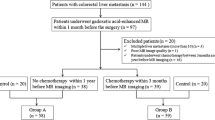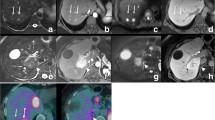Abstract
Purpose
To compare detection rates of NET liver metastases of MRI and Ga-68-DOTATATE PET/CT to provide more clarity when selecting diagnostic imaging tests for NET staging.
Methods
In this IRB-approved single-institution retrospective study, all patients with pathology-proven NET who underwent Ga-68-DOTATATE and MRI scans within 8 weeks of each other (3/2017–2/2020) were reviewed. Number of metastases for each patient on diffusion-weighted imaging (DWI), dynamic contrast-enhanced (DCE) MRI, and Ga-68 DOTATATE were recorded by two blinded radiologists, followed by consensus review with two separate blinded readers for MRI and nuclear medicine. Per-lesion and -modality scoring at each lesion location were then performed in consensus. Per-patient linear regression was performed comparing MRI and Ga-68 DOTATATE detection rates for each reader and in consensus, and per-lesion-matched pair difference means were used to compare detection frequency between modalities.
Results
32 patients (mean age 59 years, 59.4% male) and 90 liver metastases were analyzed. Intraclass coefficients (ICC) [95% CI] between the two readers were 0.97 [0.95, 0.99], 0.89 [0.82, 0.94], and 0.98 [0.97, 0.99] for Ga-68 DOTATATE, DWI, and DCE, respectively. Matched per-lesion mean differences were + 0.17 ± 0.07 (p = 0.01) and + 0.22 ± 0.06 (p = < 0.001) for DWI versus Ga-68 DOTATATE and DCE vs Ga-68 DOTATATE, respectively, favoring MRI. Case-based linear regressions estimate that DWI and DCE detect 1.28 [1.07, 1.49] and 1.33 [1.12, 1.54] lesions, respectively, for each one detected on Ga-68 DOTATATE.
Conclusion
MRI detects more hepatic NET metastasis in comparison to Ga-68 DOTATATE. Liver MRI should be performed in concert with Ga-68 DOTATATE in NET staging.
Graphic abstract






Similar content being viewed by others
Data Availability
Raw data were generated at Beth Israel Deaconess Medical Center. Derived data supporting the findings of this study are available from the corresponding author L. L. T. on request.
References
Klöppel G (2017) Neuroendocrine Neoplasms: Dichotomy, Origin and Classifications. Visc Med 33:324–330. https://doi.org/https://doi.org/10.1159/000481390
Sanli Y, Garg I, Kandathil A, et al (2018) Neuroendocrine Tumor Diagnosis and Management: (68)Ga-DOTATATE PET/CT. AJR Am J Roentgenol 211:267–277. https://doi.org/https://doi.org/10.2214/AJR.18.19881
Sarmiento JM, Heywood G, Rubin J, et al (2003) Surgical treatment of neuroendocrine metastases to the liver: a plea for resection to increase survival. J Am Coll Surg 197:29–37. https://doi.org/https://doi.org/10.1016/S1072-7515(03)00230-8
Chamberlain RS, Canes D, Brown KT, et al (2000) Hepatic neuroendocrine metastases: does intervention alter outcomes? J Am Coll Surg 190:432–445. https://doi.org/https://doi.org/10.1016/s1072-7515(00)00222-2
Rindi G, D’Adda T, Froio E, et al (2007) Prognostic factors in gastrointestinal endocrine tumors. Endocr Pathol 18:145–149. https://doi.org/https://doi.org/10.1007/s12022-007-0020-x
Musunuru S, Chen H, Rajpal S, et al (2006) Metastatic neuroendocrine hepatic tumors: resection improves survival. Arch Surg Chic Ill 1960 141:1000–1004; discussion 1005. https://doi.org/10.1001/archsurg.141.10.1000
National Comprehensive Cancer Network 2019? Guidelines for Neuroendocrine Tumors
Frilling A, Sotiropoulos GC, Li J, et al (2010) Multimodal management of neuroendocrine liver metastases. HPB 12:361–379. https://doi.org/https://doi.org/10.1111/j.1477-2574.2010.00175.x
Appetecchia M, Baldelli R (2010) Somatostatin analogues in the treatment of gastroenteropancreatic neuroendocrine tumours, current aspects and new perspectives. J Exp Clin Cancer Res CR 29:19–19. https://doi.org/https://doi.org/10.1186/1756-9966-29-19
d’Assignies G, Fina P, Bruno O, et al (2013) High sensitivity of diffusion-weighted MR imaging for the detection of liver metastases from neuroendocrine tumors: comparison with T2-weighted and dynamic gadolinium-enhanced MR imaging. Radiology 268:390–399. https://doi.org/https://doi.org/10.1148/radiol.13121628
Dromain C, de Baere T, Lumbroso J, et al (2005) Detection of liver metastases from endocrine tumors: a prospective comparison of somatostatin receptor scintigraphy, computed tomography, and magnetic resonance imaging. J Clin Oncol Off J Am Soc Clin Oncol 23:70–78. https://doi.org/https://doi.org/10.1200/JCO.2005.01.013
Lavelle LP, O’Neill AC, McMahon CJ, et al (2016) Is diffusion-weighted MRI sufficient for follow-up of neuroendocrine tumour liver metastases? Clin Radiol 71:863–868. https://doi.org/https://doi.org/10.1016/j.crad.2016.05.016
Wild D, Bomanji JB, Benkert P, et al (2013) Comparison of 68Ga-DOTANOC and 68Ga-DOTATATE PET/CT within patients with gastroenteropancreatic neuroendocrine tumors. J Nucl Med Off Publ Soc Nucl Med 54:364–372. https://doi.org/https://doi.org/10.2967/jnumed.112.111724
Kabasakal L, Demirci E, Ocak M, et al (2012) Comparison of 68Ga-DOTATATE and 68Ga-DOTANOC PET/CT imaging in the same patient group with neuroendocrine tumours. Eur J Nucl Med Mol Imaging 39:1271–1277. https://doi.org/https://doi.org/10.1007/s00259-012-2123-y
Poeppel TD, Binse I, Petersenn S, et al (2011) 68Ga-DOTATOC versus 68Ga-DOTATATE PET/CT in functional imaging of neuroendocrine tumors. J Nucl Med Off Publ Soc Nucl Med 52:1864–1870. https://doi.org/https://doi.org/10.2967/jnumed.111.091165
Jackson T, Darwish M, Cho E, et al (2021) 68Ga-DOTATATE PET/CT compared to standard imaging in metastatic neuroendocrine tumors: a more sensitive test to detect liver metastasis? Abdom Radiol N Y 46:3179–3183. https://doi.org/https://doi.org/10.1007/s00261-021-02990-4
Saqi A, Alexis D, Remotti F, Bhagat G (2005) Usefulness of CDX2 and TTF-1 in differentiating gastrointestinal from pulmonary carcinoids. Am J Clin Pathol 123:394–404. https://doi.org/https://doi.org/10.1309/UKN6-PVRK-XHG4-22DA
Modlin IM, Bodei L, Kidd M (2016) Neuroendocrine tumor biomarkers: From monoanalytes to transcripts and algorithms. Best Pract Res Clin Endocrinol Metab 30:59–77. https://doi.org/https://doi.org/10.1016/j.beem.2016.01.002
Berzaczy D, Giraudo C, Haug AR, et al (2017) Whole-Body 68Ga-DOTANOC PET/MRI Versus 68Ga-DOTANOC PET/CT in Patients With Neuroendocrine Tumors: A Prospective Study in 28 Patients. Clin Nucl Med 42:669–674. https://doi.org/https://doi.org/10.1097/RLU.0000000000001753
Funding
This research did not receive any specific grant from funding agencies in the public, commercial, or not-for-profit sectors.
Author information
Authors and Affiliations
Corresponding author
Ethics declarations
Conflict of interest
Dr. Leo Tsai is a consultant for Agile Devices, a medical device company with no connection to this study. No other author disclosures are noted.
Additional information
Publisher's Note
Springer Nature remains neutral with regard to jurisdictional claims in published maps and institutional affiliations.
Maera Haider and Brian G. Jiang are co-first authors.
Supplementary Information
Below is the link to the electronic supplementary material.
Rights and permissions
About this article
Cite this article
Haider, M., Jiang, B.G., Parker, J.A. et al. Use of MRI and Ga-68 DOTATATE for the detection of neuroendocrine liver metastases. Abdom Radiol 47, 586–595 (2022). https://doi.org/10.1007/s00261-021-03341-z
Received:
Revised:
Accepted:
Published:
Issue Date:
DOI: https://doi.org/10.1007/s00261-021-03341-z




